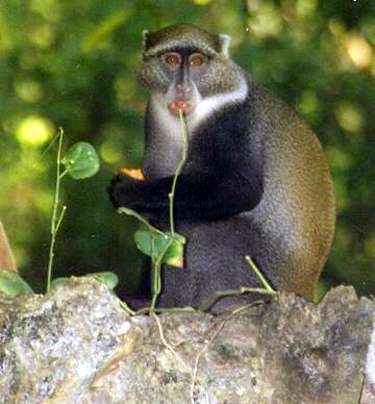Blue Monkey (Cercopithecus mitis) - Wiki Blue Monkey
From Wikipedia, the free encyclopedia
[Photo] Diademmeerkatze (Cercopithecus mitis). Quelle: Aufgenommen von Eva Hejda
The Blue Monkey or Diademed Monkey (Cercopithecus mitis) is a species of guenon native to various parts of east, central and southern Africa, including the Congo River basin.
Several subspecies are recognised. They include:
- Cercopithecus mitis mitis, found in Malawi
- Cercopithecus mitis heymansi
- Stuhlmann's Blue Monkey, Cercopithecus mitis stuhlmanni
- Elgon Blue Monkey, Cercopithecus mitis elgonis
- Cercopithecus mitis botourlinii
- Cercopithecus mitis opitsthosticus
At times some of these have been regarded as full species, while others are not recognised by all authorities as deserving subspecific status and still others not listed have been elevated to full species. The name Samango is sometimes applied to several subspecies, particularly C. m. mitis.
Despite its name, the Blue Monkey is not noticeably blue: it has little hair on its face, and this does sometimes give a blue appearance, but it never has the vivid blue appearance of a mandrill, for example. The fur is short, and mainly a grizzled brown colour apart from the face (which is dark with a pale or yellowish patch on the forehead - the "diadem" from which the species derives its common name) and the mantle, which varies between subspecies. Typical sizes are from 50 to 65 cm in length (not including the tail, which is almost as long as the rest of the animal), with females weighing a little over 4 kg and males up to 8 kg.
The Blue Monkey is found in rain forests and montane bamboo forests, and lives largely in the forest canopy, coming to the ground infrequently. It is very dependent on humid, shady areas with plenty of water. It eats mainly fruit and leaves, but will take some slower-moving invertebrates. It prefers to live in tall trees which provide both food and shelter, and are therefore, like almost all guenons, suffering from the loss of its natural habitat. Where pine plantations replace natural forest the monkey may be treated as a threat by foresters, since it sometimes strips the bark from exotic trees in a search for food or moisture. It is also hunted for bushmeat.
The mating system is polygynous, and there is a corresponding sexual dimorphism in size, with the males substantially the larger sex. Females normally give birth every two years, during the onset of the warm, rainy season; gestation is around 5 months and the infants are born with fur and with their eyes open. Group sizes range from 10 to 40, containing only a single adult male. It is often found in groups with other species of monkeys such as the Red-tailed Monkey and various red colobus monkeys.
http://en.wikipedia.org/wiki/Blue_Monkey
| The text in this page is based on the copyrighted Wikipedia article shown in above URL. It is used under the GNU Free Documentation License. You may redistribute it, verbatim or modified, providing that you comply with the terms of the GFDL. |
